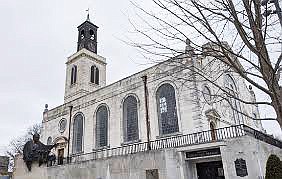For Westminster College students minoring in museum studies, having a museum on campus offers unique opportunities.
Three Westminster students recently had the chance to put together a special virtual exhibit for the National Churchill Museum focused on drafts and the prose of Winston Churchill's "Sinews of Peace" speech.
"It was a kind of surreal experience more than anything else because for me, as a child, I always love going to different museums," sophomore Stephen Rogers said.
For the online exhibit, Rogers wrote about the historical context of the 1946 speech given by the former British prime minister in Fulton, as well as the theme of global security in the speech.
"I learned a lot more about the context of the speech from reading Stephen's section," freshman Kirsten Rushing said.
Rushing contributed a section on the meaning of the title "Sinews of Peace." Though the speech is more popularly known today as the "Iron Curtain speech," Churchill's chosen name for his remarks is a metaphor for strengthening the United Nations and the relationship between the U.S. and the U.K.
"My main goal has always been to be a museum curator, so I definitely jumped at the opportunity to do something that would give me experience," junior Leah Grohs said.
Grohs's section focused on the term "Iron Curtain" and Churchill's thoughts on democracy and communism.
"I actually learned a lot because I did not know much about the speech when I first came here - all I knew was that he gave it here," Grohs said.
The students were invited to contribute by the museum.
"We have some great students who are involved in museum work and we wanted to get them involved and have experience," museum manager Susan Whitmar said. "Of course, they did great. They did actually a lot of the work - all of it basically - for the creating of the content."
Whitmar, director and chief curator Timothy Riley and curatorial intern Lena Leuci also contributed to the exhibit, helping guide the students.
"It was definitely a process - there was definitely a lot of writing and rewriting and revisions," Rogers said.
He said he learned more about the themes of the speech.
"I think if there was anything that I learned in particular about the speech was that it wasn't just a warning about the Soviet Union and what they were doing in Eastern Europe," Rogers said. "It was an advocation for the United Nations and for a strong international organization in the United Nations - but also for a strong alliance between what Churchill called the English-speaking peoples."
Dr. Mark Boulton, the chair of Westminster's history department, praised the museum for allowing students the opportunity to contribute.
"(They) have been fantastic in supporting students - giving them this kind of experience has been brilliant," Boulton said.

